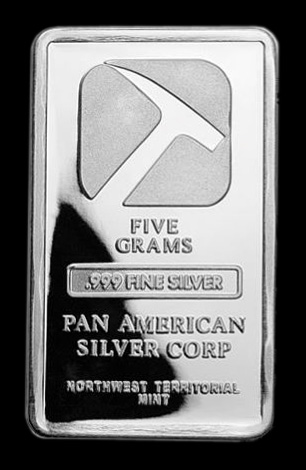5 gram Silver Bar
Share this page:
5 gram silver bars are one of the smallest silver bar sizes available. Measuring around 30.3mm (1 2 /10 inches) x 18.3mm (3 /4 inch) x 1.12mm (depending on manufacturer), the 5 gram silver bar is often seen sealed in protective plastic to preserve the mirror finish. Sometimes the bars are mounted on a dedicated assay certificate card that is the size of an ordinary credit card and these may be nicknamed "chip silver". The certificate card will typically have a serial number which of course matches the number on the bar.
5 grams is exactly 0.16075373284314 of a troy ounce and so the spot price of your silver can be calculated by multiplying number of 5 gram bars x 0.16075 x spot price. These bars are produced by several (but not all) of the major silver bullion manufacturers of the world.

5 gram Silver Bar
As with other silver bars, 5 gram silver bars are typically manufactured at .999 purity (99.9%) and this will be stamped on the bar along with the weight, manufacturer's stamp and sometimes (but not always) a serial number. In Europe, the purity is written using the system of millesimal fineness, so the number will appear as 999 - meaning 999 thousandths pure silver.
Unlike 1 oz Silver bullion coins (such as Krugerrands and U.S. Silver Eagles), which typically have the backing of Government, silver bars are not government backed money, but are certified by their manufacturers. For this reason it is often advised that investors buy silver bars manufactured by major banks and bullion corps - such as the Pan American Silver Corp bar in the image. This is because these have been certified by assay to contain the stated purity and weight of pure silver.
Gram sizes are typically more common in continental Europe, although the metric weights of silver are becoming more commonplace in the USA. Other manufacturers who have produced 5 gram silver bars include Monarch (aka MPM), Johnson Matthey, Engelhard, Scottsdale (famous for the "stacker" bars), Credit Suisse and Northwest Territorial Mint. There are also some "art bars" in the 5 gram size, such as "buffalo", zodiac signs, special limited edition designs... or anything, really. In general there are far fewer of these than 1 oz art bars. You may also see 5 gram silver made into pendants.
The small sized silver bars make attractive and interesting gift items and can be a great conversation starter. In modern times, there is often a general sentiment of wariness of paper money and some people evidently anticipate a return to the use of actual silver as currency. However one potential disadvantage of such small silver bars is that they are typically bought and sold for considerably higher than the spot price. This is because manufacturing, certification and other premiums end up being much higher for small bars. The flip side of this is that old or rare silver bars are often able to be sold to collectors for a higher price and many examples of actual prices realized can be seen on ebay.
For the above reasons these small silver bars may not have appeal to the serious investor, who is concerned more with how the math works out than with the "attractiveness" of the product. If you want the most silver you can possibly get for your money, it is suggested to buy larger bar sizes (such as 100 oz). Typically the serious investor will be comparing the final cost-per-ounce of larger silver bar sizes, so as to derive the maximum benefit from the economies of scale, or an alternative silver commodity such as junk silver coins.
However if the price of silver rises greatly, and / or if the paper money system were to collapse or suffer hyperinflation, small denomination silver bars such as these could become a useful trading item. What's fascinating is that these small bars are in one sense an idealized form of what money was originally intended to be: An exact weight of silver of guaranteed purity, which is able to be exchanged for other commodities. Also, many people are interested in owning attractive, and collectible items which also have trade value, so as to derive enjoyment from a collection in addition to future value or perhaps an item to pass on to their family in future years.
One further caution, be careful of "German Silver" bars. German silver does not contain silver, it is a nickname given to a base metal alloy. Even though the bar may have "999" written on it, and even a serial number, German silver is not silver!

Disclaimer - None of the contents of www.coinandbullionpages.com ("this website") are recommendations to buy or sell. While every care was taken in the preparation of this website and its contents, no guarantee is made as to the suitability of this website for any purpose whatsoever, nor of the accuracy, timeliness or usefulness of its information. This website is provided for general information and entertainment purposes only and the information provided on this web site should not be seen as, nor as a substitute for, legal, business or investment advice. The website's owner specifically disclaims any and all liability arising in conjunction with the use of the materials / information herein.



